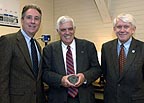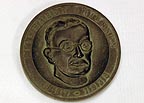October 25, 2007
SIUC's Crelling wins international award for coal research

Caption follows story
But when John C. "Jack" Crelling looks at coal, he sees endless variety in composition and uses ranging from making dyes to facilitating iron production to liquid fuel for automobiles.
For his vision and decades of work in the coal classification field, Crelling recently received the Reinhardt Thiessen Medal from the International Committee for Coals and Organic Petrology. Named for an early coal research pioneer with the U.S. Bureau of Mines, the international award is a top honor in the worldwide study of fossil fuels. Crelling, a research scientist in Southern Illinois University's Department of Geology, is one of only a handful of Americans to receive it during its 50-year history.
Crelling said the honor came as a surprise.
"I never thought I would get such an award," said Crelling, who retired from the University a year ago after almost 30 years, but continues his research, grant writing and laboratory work. "I am very lucky and happy. But I've also had great support from the University and the Coal Research Center here."
Steven P. Esling, chairperson of the Department of Geology in College of Science at SIUC, said Crelling is an internationally recognized scientist, respected throughout his field.
"He has an incredible record of achievement," Esling said. "He has now earned every major award given to a coal geologist. His past contributions to our program in teaching and research, as well as his continuing research activity, are sources of great pride to the Department of Geology."
Crelling's work focuses on characterization of coal — there are many different kinds based on what type of conditions it formed under and what material formed it. Coal characterization is critical to matching up the right kind of coal with a particular use.
Some coals, for instance, burn fast and others slowly. Some are ideal for "coking," the process of heating coal in the absence of oxygen to form a hard, sponge-like mass used in the production of iron. Still others are good for converting to liquid fuel for automobile engines.
When Crelling looks at coal, it is often through the lens of a microscope, which reveals the coal's structures and composition. Microscopic examination can reveal the kind and amount of components, called macerals, that are derived from various plant parts.
But Crelling sees more than what the microscope shows. He also sees coal's storied history and potential.
"Coal is not uniform. So it's all about understanding the behaviors of different types of coal, characterizing them and predicting how they will behave," Crelling said. "Even for something as simple as combustion, you have to know the coal."
"Probably one of the best uses of coal is an old use as a feedstock for the production of chemicals," Crelling said. "Before we had the petrochemical industry coal tar was the valuable product that supplied fertilizers, explosives pharmaceuticals, roofing and road materials. "
In the mid-1800s, an English chemist named William Perkin discovered how to make a unique fabric dye using coal tar, which previously was considered a useless byproduct of baking coal, Crelling said. He called the new color "mauve" and its fame was sealed when Queen Victoria wore a dress dyed in its hues to a wedding.
"Up until that time the only dyes were natural dyes, and it was a very muted world. When these coal tar dyes came out, it brightened the world. That was the start of organic chemistry," he said.
Crelling sees humans eventually returning to coal as a source for the chemicals on which they now depend.
"As petroleum supplies dry up we're going to have to go back to coal for these chemicals," he said. "There are other uses for it besides just burning it."
Crelling's insights and appreciation for the material led him early to an early career at Bethlehem Steel, where he led the company's coal and coke petrographic laboratories. He joined the SIUC geology faculty five years later in 1977, where he became an internationally known leader in the areas of petrographic examination of coal and manufactured carbons, and an innovator in maceral separation and fluorescent microscopy in his field.
Crelling continues conducting research and giving papers at conferences. He received the Thiessen Medal at a conference in Victoria, Canada after giving two new research papers.
Jay Means, dean of the College of Science, said Crelling is a gifted, committed professor with a long, distinguished record of academic excellence, both in the classroom and his specialization.
"Even though Jack retired from the faculty last year, he continues to contribute in significant ways to the research effort of the geology department and also to the mentoring of talented young faculty in that department," Means said. "The Thiessen Medal is the top international prize in Dr. Crelling's field and recognizes a career-long set of contributions to and major advancements in his field. I am pleased to add my congratulations to those of the faculty and Jack's peers in acknowledging this most prestigious award."

Caption follows story
Caption:
International honor — John C. "Jack" Crelling, center, holds the Reinhardt Thiessen Medal he recently received from the International Committee for Coals and Organic Petrology. Crelling, a retired but active research scientist at Southern Illinois University Carbondale's Department of Geology, received the award for his lifetime of work in the coal and organic petrology fields. With Crelling is Steven P. Esling, right, chairperson of the geology department, and Jay C. Means, dean of the College of Science at SIUC.
Photo by Russell Bailey
